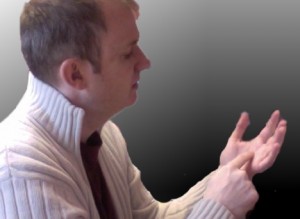Making the Language Concrete—The Hand Touch Exercise
Approaching a piece of text, any piece of text, is a daunting task. The job of the actor interpreting a text is to get the words off the page, into your “system,” and out your mouth in such a way that we feel that they are your words. To own the words, to speak them in such a way that they fulfill our needs as an actor, that they become a vehicle to reveal our inner life, and a tool whereby we can get what we need from our acting partner(s).
 Today’s text exploration task is fairly simple one. In order to marry the words to a concrete action that you’re doing, that gives you something to focus on as a means of supporting the mental working behind your speaking, I want you to focus on your non-dominant hand (if you’re right handed, focus on your left, and vice versa if you’re left handed.) Using your index finger on your dominant hand, trace a “random” pattern on your non-dominant hand as you speak your text. You might think of this being a little like doing a palm reading, and you can effectively explore this exercise with a partner, by reading their palm while speaking your text.
Today’s text exploration task is fairly simple one. In order to marry the words to a concrete action that you’re doing, that gives you something to focus on as a means of supporting the mental working behind your speaking, I want you to focus on your non-dominant hand (if you’re right handed, focus on your left, and vice versa if you’re left handed.) Using your index finger on your dominant hand, trace a “random” pattern on your non-dominant hand as you speak your text. You might think of this being a little like doing a palm reading, and you can effectively explore this exercise with a partner, by reading their palm while speaking your text.
As you touch your (or your partner’s) hand, speak the text and connect any imagery in your text with the way you touch. Allow the quality of the language, the meaning contained in the word to align with the quality of your touch. Let the specificity of word choice connect with where you touch, choosing parts of the hand to connect with individual words or short phrases. Allow the “journey” of your text travel the path your finger takes across the palm, from finger to finger. You may touch using very specific Laban-like actions: glide, flick, float, press, dab, punch, slash, wring (probably more like a grind in this context).
More than anything, make sure that your use of the text feels new to you. That you allow the way you discover the text to surprise you, to paraphrase Hamlet, by letting the action of your touch suit the words, and the words, and how you say them, suit your touch. You could explore this approach to your text a gazillion times, and each time your touch, and your speaking, would be different.
What a beaut exercise! (as we say here in Aussie-land). I’m using it now, to prepare for an audition, discovering that Paulina can be contemplative, and quite sweet, even as she’s passionate judgmental, and lying through her teeth.
I love this. I’m totally stealing it.
It reminds me a little of the “walk the text” exercise, where you change directions at every major or minor change in the direction of the thought. I suppose one could modify that exercise, making it more intimate and perhaps communicative, by tracing a finger along a partner’s palm, or perhaps even back.
For me, it is more reminiscent of Cis Berry’s exercise of Drawing a Picture while speaking a text. It’s more abstract, which makes it MORE accessible, I find, than actually drawing a real picture. Cis’s exercise is to have people draw a picture of their childhood home, which helps to personalize the text, too. But it can be very slow (especially for perfectionist drawers), which doesn’t really help.